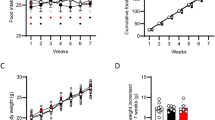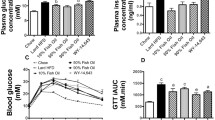Abstract.
Oleoylethanolamide (OEA), the naturally occurring amide of ethanolamine and oleic acid, is an endogenous lipid that modulates feeding, body weight and lipid metabolism by binding with high affinity to the ligand-activated transcription factor, peroxisome proliferator-activated receptor-alpha (PPAR-α). In the present article, we describe the biochemical pathways responsible for the initiation and termination of OEA signaling, and outline the pharmacological properties of this compound in relation to its ability to activate PPAR-α. Finally, we discuss the possible role of OEA as a peripheral satiety hormone.
Similar content being viewed by others
Author information
Authors and Affiliations
Corresponding author
Additional information
Received 8 November 2004; received after revision 7 December 2004; accepted 10 December 2004
Rights and permissions
About this article
Cite this article
Lo Verme, J., Gaetani, S., Fu, J. et al. Regulation of food intake by oleoylethanolamide. CMLS, Cell. Mol. Life Sci. 62, 708 (2005). https://doi.org/10.1007/s00018-004-4494-0
DOI: https://doi.org/10.1007/s00018-004-4494-0




